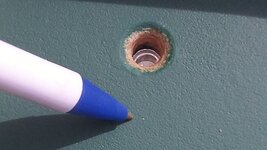ConceptualizedNetherlandr
Bronze Member
This is where gold is lost.
It was in your system, pan, sluice, contraption, whatever, but not any more!
I have access to some sand. Actually, lots of sand. I grabbed about a gallon by screening it through #4 on site. Lots of big stuff in the discard pile on site.
I gave it a very mild and quick hydraulic separation ( blew off maybe 50%) then classified through 10 and 20 resulting in 3 groups.
This stuff is not concentrates. More like mildly worked bulk material.
So I put some in a jar (the 10- 20+) and shook it around and checked it with a hand lens I noticed some of the quartz sand has gold in it. I did a vibration separation on the flooded jar and got nice black sand grouping, and the quartz with gold in it ABOVE the black.
How are we supposed to catch this this stuff? How much of this are we all throwing out? Imagine the ratio of this gold in sand grains compared to the fines.
I took an image thru the jar, for scale there is a 0.7mm pencil lead in the second image. Very tricky to get the images. This particular grain is larger than 1mm and would be retained on a 16 mesh.
It was in your system, pan, sluice, contraption, whatever, but not any more!
I have access to some sand. Actually, lots of sand. I grabbed about a gallon by screening it through #4 on site. Lots of big stuff in the discard pile on site.
I gave it a very mild and quick hydraulic separation ( blew off maybe 50%) then classified through 10 and 20 resulting in 3 groups.
This stuff is not concentrates. More like mildly worked bulk material.
So I put some in a jar (the 10- 20+) and shook it around and checked it with a hand lens I noticed some of the quartz sand has gold in it. I did a vibration separation on the flooded jar and got nice black sand grouping, and the quartz with gold in it ABOVE the black.
How are we supposed to catch this this stuff? How much of this are we all throwing out? Imagine the ratio of this gold in sand grains compared to the fines.
I took an image thru the jar, for scale there is a 0.7mm pencil lead in the second image. Very tricky to get the images. This particular grain is larger than 1mm and would be retained on a 16 mesh.






 ... enough of them and it becomes attractive. Look at what is probably the worlds second largest known gold deposit -
... enough of them and it becomes attractive. Look at what is probably the worlds second largest known gold deposit -



